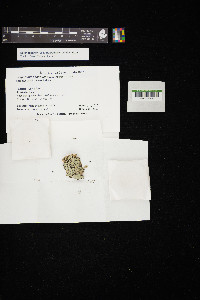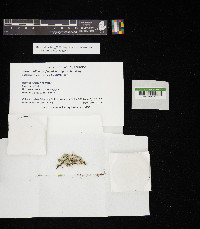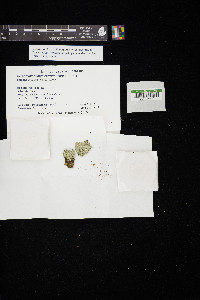
- Home
- Search
- Images
- Species Checklists
- US States: O-Z >
- US National Parks
- Central America
- South America
- US National Parks
- Southern Subpolar Region
|
|
|
|
Family: Arthoniaceae
|
in Aptroot, Thor, Lücking, Elix & Chaves, Biblthca Lichenol. 99: 35 (2009) Thallus corticolous, delimited by a compact brown prothallus; thallus surface grayish to greenish white, ecorticate, arachnoid to cottony, in the center densely covered by pale beige to grayish white, loose, ‘fluffy’, ±cylindrical to sparsely branched pseudisidia, (20-)30-40(-60) µm in diam.; medulla white, lacking calcium oxalate crystals; asci not observed; pycnidia not observed. Spot tests and chemistry: P-, K-, C-, KC-; UV- (pale), ILugol’s-; confluentic and/or hyperconfluentic acid. Distribution and ecology: Pantropical, new to Galapagos and Ecuador; all specimens collected in the humid zone, both on native and introduced trees, rarely on rock, in shaded and sheltered habitats. Notes: How well the Galapagos material corresponds to C. confluenticum s.str. remains uncertain. Unlike the description in the protologue (Aptroot et al. 2009), the few Galapagos specimens collected so far are all small, very thin and have poorly developed thalli. With storage in the herbarium their pseudisidia develop a ±pale pinkish hue similar to fresh pseudisidia of Syncesia leprobola, a species for which these specimens were originally mistaken. Thalli of S. leprobola, however, do not contain confluentic acid; instead they are characterized by protocetraric acid and thus react distinctly P+ red. The Galapagos specimens have a conspicuous, relatively compact brown prothallus that clearly delimits individual thalli. The description of this species in Aptroot et al. (2009) mentions a dirty whitish prothallus and a whitish to brownish hypothallus, but the photo therein (Fig. 3D) shows a much better developed specimen, which also appears to be delimited by a fine brown line. Specimens examined: Ecuador: Galapagos: Isla Floreana, Asilo de la Paz, Cerro Wittmer, road to Post Office Bay, 1°18’41.29”S, 90°27’4.29”W, humid zone, on bark, 03-Jan-2010, Hillmann GAL-81 (CDS 44907); Isla Isabela, Volcán Alcedo, outer E-exposed slope just below the crater rim, 0°25’17”S, 91°5’8”W, alt. 1077m, humid zone, on rock, 08-Mar-2006, Aptroot, A. 65176 (CDS 31760); Isla Santa Cruz, línea del Parque Nacional Galápagos, sector el Camote a lindero de la finca de Don René Valle, 0°38’21.10”S, 90°17’57.20”W, alt. 487m, zona húmeda, sobre corteza, 10-Aug-2006, Nugra 135 (CDS 32789); Nugra 137 (CDS 32791); along trail from Media Luna to El Puntudo, 0°39’9.80”S, 90°19’59.29”W, alt. 724m, humid zone, on bark, 10-Aug-2008, Clerc 08-114 (CDS 39968); Steve Divine Farm, near Tortoise Road, off the main road to Baltra, at the entrance to lava tunnel, Tortoise Territory, 0°39’51”S, 90°24’16”W, alt. 364m, humid zone, agricultural area, on rock, 23-Feb-2006, Bungartz 3966 (CDS 27848). from: |

![Herpothallon aff. confluenticum Aptroot & Lücking [Nugra, F. 137 (CDS 32791)] Herpothallon confluenticum image](/imglib/lichens/CDS_Lichens/00032/CDS_32791_MX_1746_print_1556317325.jpg)



















